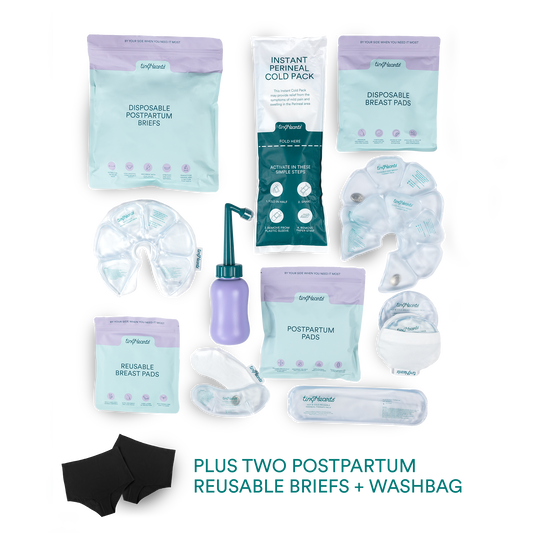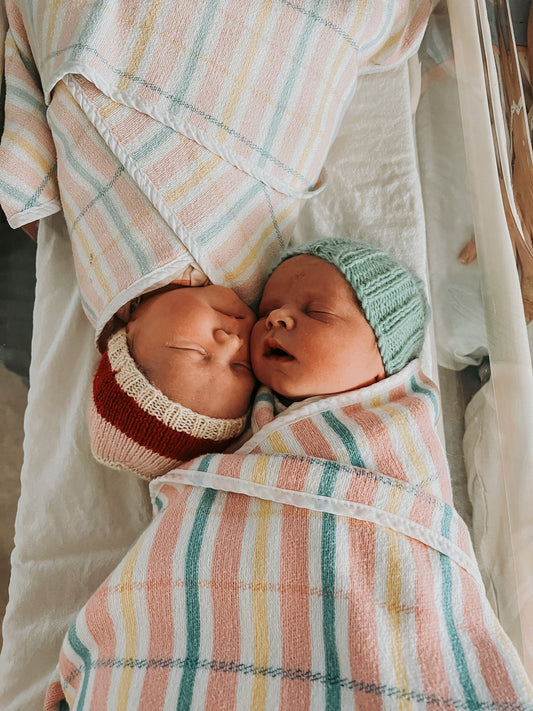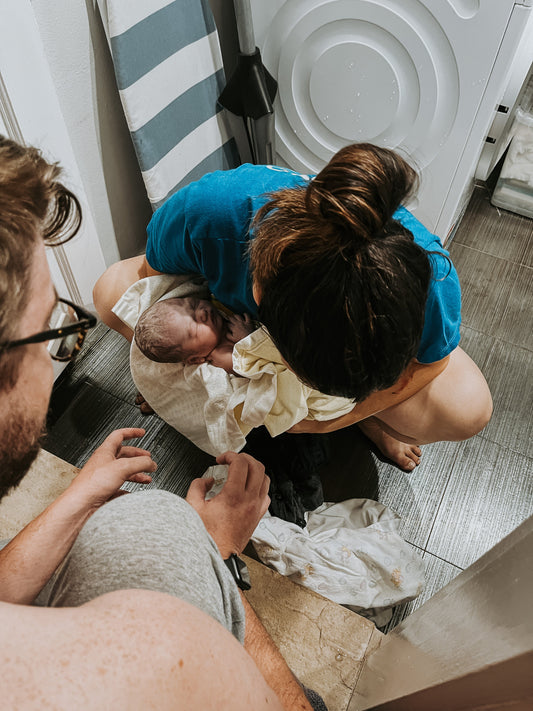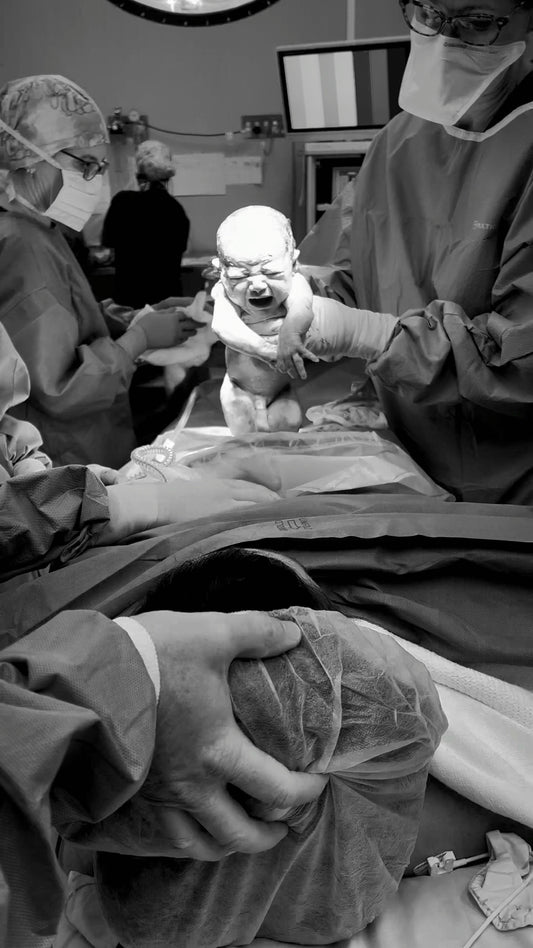So, you’ve just given birth - congratulations!
When a baby enters the world, most breathe and cry within a few seconds of being born. If your bub is breathing well, they will be placed onto your chest or belly straight after birth - this is also known as skin-to-skin. This naked skin contact helps to keep your little one warm, helps to steady their breathing and heart rate. Plus! This technique helps you to bond with each other physically, and it helps to trigger breastfeeding.
While you and bub are having some skin-to-skin time, your midwife will dry bub and cover you both with warm blankets or towels.
Similar to uncomplicated vaginal births, most bubs who are born with the help of forceps or a vacuum will breathe and cry within a few seconds of being born. However, some bubs may be a little stunned or slow to breathe - especially if they experienced distress during labour.
If your bub doesn’t cry or breathe straight, your midwife, obstetrician or paediatrician will take your baby to a warming station. Here they will dry your little one and ensure that they’re breathing well on their own.
Once bub is breathing okay, they’ll be dried, wrapped in warm towels or blankets, and given to you for a cuddle. This is when you’ll be able to have skin-to-skin contact.

Caesarean Section: Elective
Babies born via an elective caesarean section, will not only cry and breathe at birth, but they often do so in a forceful manner. Because of this, after your bub is born, your midwife or obstetrician will take your little one to the warming station to dry, assess and check their breathing.
Once they’ve wrapped your bub in warm towels or a blanket, you will be given your little one to hold, while you’re being stitched back up (that is, unless you’ve had a general anaesthetic - then your bub will likely be given to your support person). Depending on the hospital and your birthing team, you may be able to have skin-to-skin contact as soon as your baby is born. We recommend chatting with your birthing team to see if you can do this.
Sometimes, you may need further medical attention - because, let’s not forget a caesarean section is a major surgery to your stomach and uterus. If this is the case, the baby will be given to your support person for lots of cuddles until you are back in recovery or the maternity ward. Some hospitals even let the support person provide skin-to-skin contact with bub in the theatre if you are unable to.

Caesarean Section: Unplanned or Emergency
Generally speaking, babies born via emergency caesareans are likely to need help breathing at birth - this is because the labour was likely distressing. Like an elective caesarean, your bub will be taken to a warming station where they will be dried and assessed by your midwife and obstetrician to determine their particular needs.
Once bub is breathing well, and your health is stable, they will wrap your baby in warm towels or a blanket and pass them to you for cuddles, while you’re still on the operating table (again, this will not be possible if you have had a general anaesthetic).
If your baby requires a lot of help breathing, they may be taken straight to the Neonatal Intensive Care Unit, which is commonly referred to as the NICU. Depending on the treatment your child needs, your first cuddle may be delayed until bub is well. While this can be extremely difficult for parents, remember that the staff in these units have yours and your bubs best interests at heart and will do absolutely everything in their power to get your little one back to good health!
What happens if your bub needs medical help:
If your baby isn’t breathing properly upon exiting the womb and needs help to breathe, has a low heart rate or is floppy, they will be relocated to the warming station where your care providers will decide whether or not they need extra help.
Your obstetrician or midwife may attempt to clear your baby’s airways and help them to breathe by giving them normal air through a special infant mask and breathing device. This mask may stay on until your bub can breathe on their own.
If their breathing, heart rate or floppiness does not improve, they will likely need oxygen which will be delivered via a mask or breathing tube. If resuscitation is required at birth, they’ll be taken to the Special Care Nursery (SCN) or the NICU.

Cutting of the Umbilical Cord
After any type of birth, your baby’s umbilical cord will need to be clamped and cut. While the cord is quite tough to cut, it isn’t painful for you or your bub - phew!
It’s up to you who cuts the cord. It can either be your birth partner or your care providers. It will depend on the type of birth who will be able to cut the cord. For example, if it’s an uncomplicated vaginal birth, you will be able to pick who cuts the cord.
If your bub needs to be taken to a warming station after birth or if you have complications like heavy bleeding - your midwife or obstetrician will clamp and cut the cord.
APGAR Testing
In the first few hours of life, a test known as the APGAR score will be performed on your bub by your midwives. This test is a score that rates your baby’s heart rate, breathing, muscle tone, response to stimuli and skin colour. A score of 0, 1 or 2 is given for each of these categories and make up the total APGAR score.
Why is this done? This score measures how well your bub has the made the transition from life inside the womb to life earth-side.
Checks and medication in the first few hours
Within the first hour of birth, your midwife will put two name tags on your baby (so they know it’s yours!), they will weigh bub and perform a quick physical check.
Your midwife will record when your child does their first poos and wees, and this will usually occur within the first 24 hours. They will also ask for your permission to have two injections placed into your bub’s thigh after birth, these are:
- Vitamin K - to prevent a bleeding disorder known as hemorrhagic disease of the newborn
- Hepatitis B Immunisation - the only immunisation required birth. This is given as per Australia’s universal immunisation program
Within the first 48-72 hours of bub’s life, you’ll be asked to give consent for your little one to undergo newborn screening, which tests for signs of rare conditions. They will also be checked for developmental dysplasia of the hip (DDH) and screened for hearing impairment in the early days of their life.

We urge you to chat about all of these processes with your midwife, GP or obstetrician near the end of your pregnancy, so you’re aware of what exactly what’s install for you!







